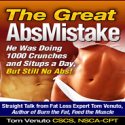Fat Loss Nutrition: What is it and How to pursue it!
Fat Loss Nutrition is a simple term to describe a way to eat in order to aim for fat loss instead of mere and plain weight loss.
Having that explained, we need to bear in mind that although our eating
habits are the ones that make or break our fat loss efforts, only with
the addition of daily workout routines we will succeed in our goals in a
timely manner.
Our every day decisions about our daily diet are
the key steps towards, or away, a leaner and fitter you. Based on that
information a fat loss nutrition plan is due.
A fat loss
nutrition plan is a plan which would consist of the recommended amounts
of carbohydrates, proteins and fats as well as provide our bodies with
minerals, vitamins and all essential nutrients which maintain them
healthy and vibrant as they are meant to be.
A strong support to
that end would also be to carefully choose the quality of the foods
consumed daily. When it comes to food, to me quality is synonym to organic. In order to maximize the effects of my efforts on my body I am going organic even though it might be a little more expensive.
Best ratio of macronutrients in our diets.
A correctly chosen fat loss nutrition plan should contain a certain
amount of all three macronutrients (carbs, proteins and fats). That
certain amount has been the object of several studies which wanted to
identify the ideal ratio in our diets.
According to the Food and
Nutrition Board and Acceptable Macronutrient Distribution Ranges
(AMDRs), an ideal and healthy nutrition plan for adults should include
10-35% proteins, 20-35% fats, and 45-65% carbohydrates.
Some
experts, like Joanne Larsen, registered dietician and nutrition
therapist from Nutritional Data Services, recommends our diet to include
roughly 20% proteins, 30% fats, and 50% carbs.
How to pursue it.
In order to design a customized fat loss nutrition plan we need to keep
in mind factors such as the current health condition, lifestyle, our fat
loss goals, our determination to stick to a plan altogether and the
expected timeframe within which we want certain results.
One more
thing we need to know is how to read food labels in order to understand
how a certain food can add to our caloric intake and derail us from our
fat loss track. Reading food labels is easy once you are aware of the
information of the table hereafter:
Macronutrient(per 1gr)------Calories-------Kilojoules
Protein -------------------------- 4--------- 16.7
Fat------------------------------ 9--------- 37.7
Carbohydrate-------------------- 4--------- 16.7
Let’s see an example of how to read a label:
We have an energy bar of a well known company which claims to have a net weight of 40 grams and it contains 21 grams of carbs, 3 grams of protein,6 grams of fat.
The calorie intake of this bar is 150 Kcal and we want to find out how many of this kcal’s are carbs, proteins and fats.
We multiply the number of grams with the number of calories found next to each macronutrient and there you have the nutrition value of this bar.In our example 21 grams multiplied by 4 is 84 kcals of carbs, 6 grams multiplied by 9 is 54 kcals of fat and 3 grams multiplied by 4 is 12 kcals of protein.Add 84 + 54 + 12 = 150 Kcals
What should be our main focus.
It goes without saying that when we design a fat loss nutrition plan we
should focus not only on those three macronutrients but in vitamins,
such as A, B, C, D, E and others, which assist in maintaining a healthy
condition and prevent the occurrence of numerous diseases and illnesses.
Moreover
we should be looking for minerals like calcium, magnesium, sodium,
phosphorus, potassium, zinc, manganese, and others, which are vital for
our wellbeing as our bodies can not synthesize those on their own.
Minerals assist the completion of most chemical processes, the
maintenance of our heart rhythm, our neural conductivity, our muscle
contractility, as well as the formation of our bones and teeth.
Fat
loss nutrition seems more complex than it actually is. I know that to
most people the terms macronutrients , minerals , vitamins not only
sound as “Chinese” but they are boring too.
In order to be
successful to your fat loss goals you have the option to go to a
nutrition expert and pay him to make you a plan to follow. However I
believe that if someone has the ability and the determination to plan a
few days ahead, all that needs to be done is to design fat loss meal
plans, follow the macronutrients ratio mentioned earlier and select
foods from the fat burning foods list.
Once that is done then it
is almost certain you will get most , if not all, of the required
vitamins , minerals and macronutrients.
Return from fat loss nutrition to fat loss guide
Join our
Fat Fighters Newsletter
and receive for FREE
a copy of... 
...that will provide you with the absolutely necessary to, finally, reveal your abs!






New! Comments
Have your say about what you just read! Leave me a comment in the box below.